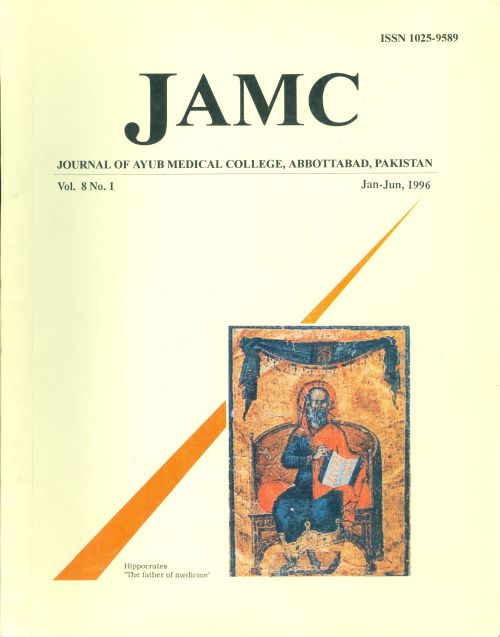ARI IN CHILDREN: A CASE MANAGEMENT INTERVENTION IN ABBOTTABAD
Abstract
A community-based program of acute lower respiratory infection (ALRI) case management was conducted in a rural district of northern Pakistan. The impact on infant and child mortality of this program was evaluated. During 1985-1986, ALRI-specific mortality among children <5 years old living in 31 intervention villages was 6.3 deaths per 1 ( X X ) children per year compared with 14.4 in seven control villages (p=0.0001). Within one year after interventions were extended to the control villages in 1987, ALRI-specific mortality in these villages dropped by 55% to 6.5 per I ( X X ) children per year (p=0.06). Total child mortality in 1985-86 was 29.0 per 1000 children per year in the intervention villages and 39.4 in the control villages, a difference of 287c ft=0.01). With interventions in 1987, total child mortality in the control villages declined by 297c to 27.8 per 1000 children per year (p=0.09).References
World Health Organization. The work of WHO.
-1987: Biennial report of the Director-General,
Geneva, WHO, 1983; pp 171-173.
World Health Organization. A programme for
controlling acute respiratory' infections in children:
Memorandum from a WHO meeting. Bull WHO,
; 62: 47-58.
Pio A. Acute respiratory infections in developing
countries: An international point of view. Pediatr
Infect Dis, 1986; 5: 179-183.
CherianT, John TJ, Simoes E, Steinhoff MC & John
M. Evaluation of simple clinical signs for the
diagnosis of acute lower respiratory tract infection.
Lancet, 1988; 2: 125-128.
Shann F. Hart K & Thomas D. Acute lower
respiratory tract infections in children: possible
criteria for selection of patients for antibiotic therapy
and hospital admission. Bull WHO, 1984; 62: 749-
World Health Organization. Case management of
acute respiratory infections in children: intervention
studies. WHO/ARI/88.2, 1988; Geneva, WHO.
Datta N, Kumar V. Kumar L & Singhi S. Application
of case management to the control of acute
respiratory infections in low- birth weight infants: a
feasibility study. Bull WHO. 1987; 65: 77-82.
Mtango FDE and Neuvians D. Acute respiratory'
infections in children under five years. Control
project in Bagamayo District, Tanzania. Trans R Soc
Trop Med Hyg, 1986; 8(1: 851-858.
The Kasongo Project Team. Influence of measles
vaccination on survival pattern of 7 to 35-month-old
children in Kasongo, Zaire. Lancet, 1981; i: 764-767.
Pio A. Leowski J & Ten DHG. The magnitude of the
problem of acute respiratory' infections. In: Douglas
RM & Kerby-Eaton E, Acute Respiratory Infections
in Childhood. University of Adelaide, Australia,
; pp 3- 16.
Berman S, Duenas A, Bedoya A, et al. Acute lower
respiratory tract illnesses in Cali, Colombia: A twoyear
ambulatory study. Paediatrics, 1983; 71: 210-
Pandey MR, Sharma PR & Neupane RP. Preliminary
report of a community study of childhood ARI in
Nepal. In: Douglas RM & Kerby-Eaton E. Acute
Respiratory Infections in Childhood. University of
Adelaide, Australia, 1985; pp 131-135.
Kendall PA and Leeder SR. Environmental factors
relating to acute respiratory infections in childhood:
possibilities for prevention. In: Douglas RM &
Kerby-Eaton E. Acute Respiratory Infections in
Childhood, University of Adelaide, Australia, 1985;
pp 72-77.
Lepage P, Munyakazi C & Hennart P. Breast feeding
and hospital mortality in children in Rwanda. Lancet,
; 2: 409-411.
Kirkwood B. Community-based intervention trials.
Presentation at the British Society for Population
Studies conference, "Health interventions and
mortality change in developing countries".
University of Sheffield, England, 1987.
Blum D & Feachem RG. Measuring the impact of
water supply and sanitation investments on
diarrhoeal diseases: problems of methodology. Int J
Epidemiol, 1983; 12: 357- 365.
Downloads
How to Cite
Issue
Section
License
Journal of Ayub Medical College, Abbottabad is an OPEN ACCESS JOURNAL which means that all content is FREELY available without charge to all users whether registered with the journal or not. The work published by J Ayub Med Coll Abbottabad is licensed and distributed under the creative commons License CC BY ND Attribution-NoDerivs. Material printed in this journal is OPEN to access, and are FREE for use in academic and research work with proper citation. J Ayub Med Coll Abbottabad accepts only original material for publication with the understanding that except for abstracts, no part of the data has been published or will be submitted for publication elsewhere before appearing in J Ayub Med Coll Abbottabad. The Editorial Board of J Ayub Med Coll Abbottabad makes every effort to ensure the accuracy and authenticity of material printed in J Ayub Med Coll Abbottabad. However, conclusions and statements expressed are views of the authors and do not reflect the opinion/policy of J Ayub Med Coll Abbottabad or the Editorial Board.
USERS are allowed to read, download, copy, distribute, print, search, or link to the full texts of the articles, or use them for any other lawful purpose, without asking prior permission from the publisher or the author. This is in accordance with the BOAI definition of open access.
AUTHORS retain the rights of free downloading/unlimited e-print of full text and sharing/disseminating the article without any restriction, by any means including twitter, scholarly collaboration networks such as ResearchGate, Academia.eu, and social media sites such as Twitter, LinkedIn, Google Scholar and any other professional or academic networking site.










